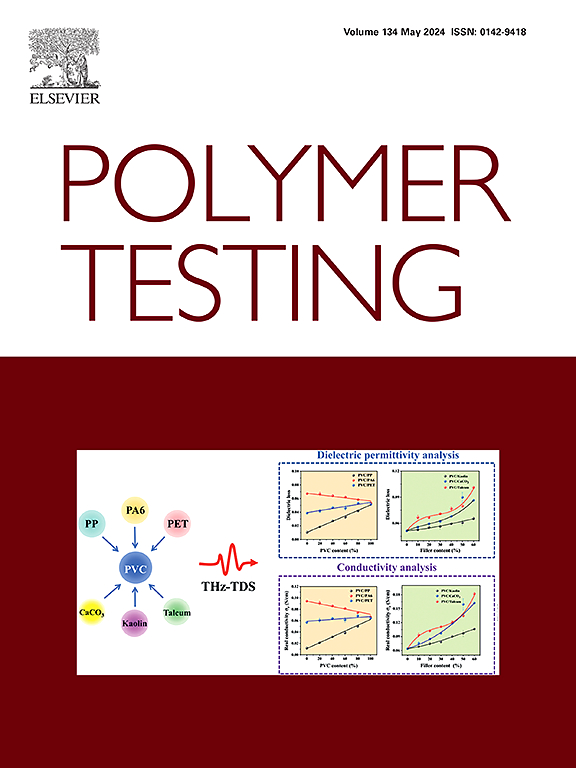调节金属-咪唑配位相互作用增强金属超分子聚合物中激波能量耗散
IF 6
2区 材料科学
Q1 MATERIALS SCIENCE, CHARACTERIZATION & TESTING
引用次数: 0
摘要
开发具有冲击波能量耗散(SWED)能力的材料对于现代防护应用至关重要。在这项研究中,金属超分子聚二甲基硅氧烷(PDMS)网络与Zn2+、Cu2+、Ni2+离子和咪唑配体交联,通过利用金属配体配位键的动态特性来增强SWED。一项激光诱导激波技术表明,Cu2+交联PDMS表现出优越的SWED性能,这可能是由于在激波耗散的相关时间尺度内发生了配位重排动力学。时间-温度叠加(TTS)分析表明,虽然缔合配体交换可能有助于冲击衰减,但在极端冲击条件下,金属-配体键解离发挥更大的作用。DFT计算进一步表明,配位几何对SWED性能有显著影响,方形平面(反)配位中的Cu2+表现出更大的破裂敏感性。这些发现强调了金属-配体相互作用的可调性是优化金属超分子聚合物能量耗散的有效策略。此外,他们通过协同整合激光诱导冲击波测试和DFT计算,提供了全面的SWED机制分析。本文章由计算机程序翻译,如有差异,请以英文原文为准。

Enhancing shock wave energy dissipation in metallosupramolecular polymer by tuning metal-imidazole coordination interactions
The development of materials capable of shock wave energy dissipation (SWED) is critical for modern protective applications. In this study, metallosupramolecular poly(dimethylsiloxane) (PDMS) networks cross-linked with Zn2+, Cu2+, and Ni2+ ions and imidazole ligands were designed to enhance SWED by leveraging the dynamic nature of metal-ligand coordination bonds. A laser-induced shock wave technique revealed that Cu2+ cross-linked PDMS exhibited superior SWED performance, likely due to coordination rearrangement dynamics occurring within a relevant timescale for shock wave dissipation. Time-temperature superposition (TTS) analysis indicated that while associative ligand exchange may assist in shock attenuation, metal-ligand bond dissociation plays a more dominant role under extreme shock conditions. DFT calculations further demonstrated that coordination geometry significantly influences SWED performance, with Cu2+ in square planar (trans) coordination exhibiting greater rupture susceptibility. These findings highlight the tunability of metal-ligand interactions as an effective strategy for optimizing energy dissipation in metallosupramolecular polymers. Additionally, they provide a comprehensive SWED mechanism analysis by synergistically integrating a laser-induced shock wave test and DFT calculations.
求助全文
通过发布文献求助,成功后即可免费获取论文全文。
去求助
来源期刊

Polymer Testing
工程技术-材料科学:表征与测试
CiteScore
10.70
自引率
5.90%
发文量
328
审稿时长
44 days
期刊介绍:
Polymer Testing focuses on the testing, analysis and characterization of polymer materials, including both synthetic and natural or biobased polymers. Novel testing methods and the testing of novel polymeric materials in bulk, solution and dispersion is covered. In addition, we welcome the submission of the testing of polymeric materials for a wide range of applications and industrial products as well as nanoscale characterization.
The scope includes but is not limited to the following main topics:
Novel testing methods and Chemical analysis
• mechanical, thermal, electrical, chemical, imaging, spectroscopy, scattering and rheology
Physical properties and behaviour of novel polymer systems
• nanoscale properties, morphology, transport properties
Degradation and recycling of polymeric materials when combined with novel testing or characterization methods
• degradation, biodegradation, ageing and fire retardancy
Modelling and Simulation work will be only considered when it is linked to new or previously published experimental results.
 求助内容:
求助内容: 应助结果提醒方式:
应助结果提醒方式:


